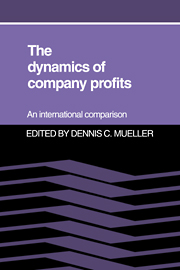Book contents
- Frontmatter
- Contents
- Preface
- Contributors
- 1 Profits and the process of competition
- 2 Modeling persistent profitability
- 3 The persistence of profits in the United States
- 4 The persistence of profits in U.S. manufacturing industries
- 5 The persistence of profitability in Canada
- 6 The persistence of corporate profits in the Federal Republic of Germany
- 7 The persistence of profits in France
- 8 The persistence of profits in Japan
- 9 The persistence of profits in the United Kingdom
- 10 The persistence of profits: international comparison
- 11 The persistence of profits in perspective
- References
- Index
9 - The persistence of profits in the United Kingdom
Published online by Cambridge University Press: 03 May 2010
- Frontmatter
- Contents
- Preface
- Contributors
- 1 Profits and the process of competition
- 2 Modeling persistent profitability
- 3 The persistence of profits in the United States
- 4 The persistence of profits in U.S. manufacturing industries
- 5 The persistence of profitability in Canada
- 6 The persistence of corporate profits in the Federal Republic of Germany
- 7 The persistence of profits in France
- 8 The persistence of profits in Japan
- 9 The persistence of profits in the United Kingdom
- 10 The persistence of profits: international comparison
- 11 The persistence of profits in perspective
- References
- Index
Summary
Introduction
That the recent performance of the U.K. economy has been poor is beyond dispute. One diagnosis of this state of affairs asserts that the cause of the problem arises from the fact that U.K. markets are, in general, rather uncompetitive. There are two steps to the argument. The first asserts that strong and vigorous competitive processes stimulate the kinds of innovativeness and general dynamism that generate rapid economic growth and development. Entry and fringe firm activity, it is argued, encourage the generation and diffusion of new products and techniques and provide the kind of pressure needed to keep all industry members alert, efficient, and flexible. The second strand of the argument asserts that the competitive process in the United Kingdom is, in fact, quite weak. Relatively low rates of innovation and productivity increases, sluggish price responses to cost and demand changes, and a poor balance of trade in medium and high technology products are all taken to point to a lack of dynamism. Further, U.K. industries are highly concentrated, and high gross entry flows in the United Kingdom appear to produce little more than high gross exit flows. That the two sets of facts are associated is suggested by studies that indicate that highly concentrated, low entry industries may be less innovative and less price flexible than others (e.g., Encaoua and Geroski, 1986; Geroski, 1987). Although not conclusive, the overall argument has at least prima facie appeal.
Are industries in the United Kingdom competitive enough to ensure satisfactory rates of innovation and growth? To answer this, one must define the adjective “competitive” and then measure how extensive the force of competition is in various industries.
- Type
- Chapter
- Information
- The Dynamics of Company Profits , pp. 147 - 168Publisher: Cambridge University PressPrint publication year: 1990
- 18
- Cited by



